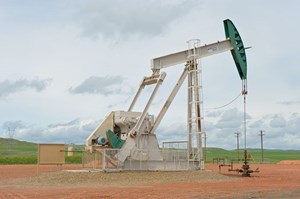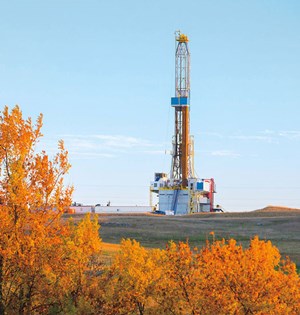Shaletech: Bakken-Three Forks Shale
The titular “cash engine” that is the Bakken-Three Forks shale has been running on fumes. But most of the operators left standing after a wave of consolidations are gearing up for what promises to see the Williston basin play regain some of its grit, as the year unfolds.

While completion spreads replaced drilling rigs early in the year, as operators whittled down drilled-but-uncompleted (DUC) wells, new well construction began a turnaround of sorts in the second quarter, after a pandemic-wrecked year that saw drilling fall to a low of nine active rigs in August, according to Baker Hughes. As of June 2, 20 rigs spread out between 10 operators were active in the North Dakota fairway of the Bakken (Fig. 1), says the state’s Department of Mineral Resources (DMR).
Amid the expected production boost, operators had to reckon with the uncertain future of the embattled Dakota Access Pipeline (DAPL), a primary takeaway artery for Williston crude. Though volumes have fluctuated dramatically since 2020, the network had been transporting more than 500,000 bpd since the June 2017 start-up. The pipeline’s continued operation, however, had been in the hands of a federal judge, who denied an injunction on May 21 that would have immediately shut down the network.
The future of DAPL now rests with the results of a U.S. Corps of Engineers’ environmental impact study of a key easement, expected later this year. Concerns over potential railroad bottlenecks, and a return to notoriously high differentials, prompted producers to establish contingencies in the event of a negative judicial ruling. “We continue to believe the pipe will remain operational, but we have positioned ourselves to be able to execute on our 2021 plan under any DAPL operating condition,” said Aaron Chang, V.P. of Oil and Gas Marketing, for Bakken pioneer Continental Resources, Inc.
For now, takeaway capacity is hardly an issue. The U.S. Energy Information Administration (EIA) forecasts Bakken oil production of 1.097 MMbpd in June, which only barely exceeds the 1.003 million bpd in June 2020, when crashing prices forced wholesale, Fig. 2. Abetted by North Dakota’s tightened gas capture rules, the EIA also guesstimates June gas production to be 2,732 MMcfd, which would be up year-over-year from 2,269 MMcfd.

The demand rout of 2020 coincided with the North Dakota Public Service Commission’s decision last February to approve a since-unnecessary doubling of DAPL capacity to 1.1 MMbopd. “What’s really impacted the volumes on DAPL has been drilling. We were at 1.6 million barrels a day before the pandemic, and now we’re down around 1.1 million. So that certainly has impacted it to a certain degree,” said Mackie McCrea, group COO and chief commercial officer of DAPL operator Energy Transfer LP. “But we’re seeing it come back. There’s a lot of DUCs in the process of being completed. And there’s also some comments from some of the bigger producers that they’re going to start moving rigs.”
IMPROVED OUTLOOK
Working under a non-operating model, Northern Oil & Gas Inc. of Minneapolis, Minn., which has 182,000 acres under outright control in North Dakota, has a wide-angle view of operators’ activity. As far as the Bakken is concerned, the company likes what it sees. “All signs are certainly pointing to a general uptick in overall activity in the Williston,” says COO Adam Dirlam.
While not breaking out play specifics, the company closed six cumulative transactions in the first quarter, in the Bakken and Permian basin, with 15 proposals under evaluation as of May 7. The Williston drilling packages conservatively prioritize the more mature Bakken over the underlying Three Forks.
Operator partners, thus far, have focused on reducing a DUC inventory that stood at 647 wells in April, according to the latest available EIA data. Bakken operators entered 2021 with 778 DUC wells. As the DUC well count drops, “I think you’re going to see potential rigs and new well proposals kind of following that.” Dirlam said.
With first-quarter production down nearly 41,000 boed year-over-year, Continental, for one, intends to make up ground over the second half of 2021, with around 65 oil-weighted wells slated for completion in the second quarter alone. “Bakken production is already ramping up in the second quarter,” CEO Bill Berry said on April 29, following a quarter that saw production drop to 160,577 boed, from 201,502 boed in the first three months of 2020.
Continental entered the second quarter running four rigs, with more likely on the way. “Continental will add a few rigs as we exit the year, but don’t see a lot of increased activity anywhere on par with some of the other basins, “ says Senior V.P. of Operations Pat Bent.
Two rigs will be dedicated to beginning development drilling in August at the Long Creek asset in Williams County, N.D., where Continental targets both the Middle Bakken and Three Forks shales. A total of 56 development wells are on the board, with 11 recently completed wells delivering initial production (IP) rates of around 1,900 boed. Long Creek occupies some 5,600 net contiguous acres within Continental’s commanding 797,000-net-acre Bakken leasehold.
With total well costs targeted at 7% below those of 2020, Berry expects the composite 2021 Bakken lock-in program to deliver a more-than-70% rate of return at $60/bbl oil and $2.75/Mcf gas.
After adding a second rig in February, Hess Corp says if prices “remain strong” in the second half of the year, a third rig may join the fleet. “The primary role of the Bakken in our portfolio is to be a cash engine. As such, the decision to add any rigs in the Bakken is going to be driven by corporate returns and corporate cash flow needs,” says President and COO Gregory Hill. “Our medium-term or long-term objective would be to get the Bakken back to 200,000 barrels a day. That would probably require a fourth rig.”
Conversely, with four wells completed, EOG Resources, Inc. essentially wrapped up the 2021 drilling and completions program in the first quarter. The company does not intend to run any rigs or completion crews in 2021.
EOG doubled down on its premium drilling strategy this year, requiring any well drilled to generate a 60% after-tax return on flat $40/bbl oil and $2.50/Mcf gas prices. The company has identified 255 net undrilled premium locations within a 220,000-net-acre Bakken/Three Forks leasehold.
Meanwhile, publicly traded operators remain committed to investors’ demands for fiscal restraint, even as they snap up assets throughout the basin. “We remain committed to our $1 billion capital program. There will be no change to our capital budget, even if oil prices continue to strengthen,” says Marathon Oil Corp. CEO Lee Tillman. Around 90% of the 2021 budget will be directed to the “capital-efficient” Bakken and Eagle Ford assets.
In the largest regional acquisition this year, privately held Grayson Mill Energy LLC of Houston bought the Bakken assets of Equinor ASA. for $900 million in February. The deal included 242,000 net acres and associated midstream assets. Like its tight-lipped contemporaries, equity-backed Grayson Mill has not responded to requests for comment on planned 2021 activity.
ASSETS IN PLAY
Nearly seven months after exiting Chapter 11 bankruptcy, Oasis Petroleum Inc augmented its “cornerstone asset” with an all-cash $745-million deal for the 95,000 net acres that Diamondback Energy Inc. inherited in the March acquisition of QEP Resources.
“I think there continue to remain opportunities in the Bakken, and we’re going to have to look at those, sort of on a case-by-case basis, and see whether or not those opportunities make sense for us,” said recently inaugurated CEO Dan Brown.
The transaction, which is expected to close in July, will give Oasis a 497,000-net-acre position with combined production of around 77,000 boed. Oasis was running a single rig in North Dakota at the end of the first quarter and plans to complete 23 to 25 gross wells.
In April, Hess sold around 78,700 “non-strategic” net acres to Enerplus Corp for $312 million, one of two Williston acquisitions the Canadian-based operator closed this year. The newly acquired Little Knife and Murphy assets were in the southernmost portion of Hess’s Bakken position, where no drilling activity had been planned before 2026. Prior to the deal, Hess held around 530,000 net acres in the Bakken, which remains the company’s “largest operated asset.”
As things now stand, Hess expects net production to grow over the next six months to a 2021 exit rate of 170,000 to 175,000 boed. First-quarter production averaged 158,000 boed, well below targeted quarterly production of 170,000 boed. Hess plans to drill around 55 Bakken wells this year, with 45 expected to be turned-in-line.
Enerplus preceded the Hess deal with the $465-million acquisition of privately controlled Bruin E&P Partners LLC of Houston. The transaction included 151,000 net acres in the Williston basin, including 30,000 acres contiguous with the Calgary operator’s core Fort Berthold position. With the twin deals, Enerplus holds 296,000 net acres.
First-quarter production averaged 47,327 boed, inclusive of the Bruin acquisition, which closed on March 10, with three gross wells put onstream. After resuming a drilling program in April, Enerplus plans to run a single rig throughout 2021.
Though the Bakken ranks among the “Big Three” of its Lower 48 assets, ConocoPhillips Co. was running zero rigs or completion crews at the end of the first quarter, Fig. 3. By comparison, the company exited the first quarter with a combined 15 active rigs in the Eagle Ford and Permian basin.

CEO Ryan Lance hinted that the 620,000-net-acre Bakken asset could be expendable, as the company looks to pay down $5 billion in debt over the next five years, following the $9.7-billion acquisition of Concho Resources in January. “Globally, and here in the U.S., I think post the transaction with Concho, we want to make sure that every asset is competitive in the portfolio, and we’re not lost on the fact that it’s a reasonable market right now for sales,” he said on a May 5 call when asked about a potential divestiture.
First-quarter production of 86,000 boed was down some 10,000 boed from the first quarter of 2020.
Devon Energy Corp., however, is unlikely to be among those looking to shed a newly acquired asset. As part of its Permian-focused $2.56-billion acquisition of WPX Energy in January, Devon secured around 85,000 net acres in the Williston basin, where production averaged 61,000 boed in the first quarter. Devon expects to bring 15 to 20 wells online, in an effort to stabilize production for the remainder of the year.
“It does not have the inventory that some of our other basins do, but it is playing a very, very important role right now, and it’s cranking out a lot of cash for us. So, I think we need to keep it,” says President and CEO Rick Muncrief, the former WPX chief.
DAPL CLOSURE IMPACT
Theoretically, Marathon said that had the court ruled by June 1 that DAPL be taken offline, it would have resulted in a $50 million-to-$60-million hit to 2021 cash flow. For now, however, takeaway is not a concern. “In terms of our impact, we’ve talked about that we really only have direct exposures to DAPL of about 10,000 barrels a day, net. We have no flow assurance concerns,” Executive V.P. of Corporate Development and Strategy Pat Wagner said on May 6. “We’ve made that disclosure to try to give some clarity on what the overall impact could be for us on cash flow.”
“On a full year, we’d expect an initial sort of blowout in the in-basin differentials, but then we think things would settle down to the marginal cost to transport barrels. And there is plenty of capacity from a rail standpoint to clear the basin.”
With three new wells, along with those completed late in 2020, put to sales, first quarter production of 112,000 boed was nearly flat year-over-year. Marathon intends to hook nearly 20 wells to the sales lines in the second quarter, within a 255,000-net-acre leasehold.

- Shale: Sorry Monte Python, I’m not dead yet (December 2025)
- Below-grade well cellar enables simultaneous operations in shale plays (November 2025)
- Cleaner separation, safer future: AutoSep’s automated approach to flowback (September 2025)
- Smarter well interventions accelerate productivity (July 2025)
- From guesswork to ground truth: The rise of geomechanics in the Permian basin (July 2025)
- Executive viewpoint: Yesterday’s milestones shape tomorrow’s paradigms (June 2025)
- Subsea technology- Corrosion monitoring: From failure to success (February 2024)
- Applying ultra-deep LWD resistivity technology successfully in a SAGD operation (May 2019)
- Adoption of wireless intelligent completions advances (May 2019)
- Majors double down as takeaway crunch eases (April 2019)
- What’s new in well logging and formation evaluation (April 2019)
- Qualification of a 20,000-psi subsea BOP: A collaborative approach (February 2019)



